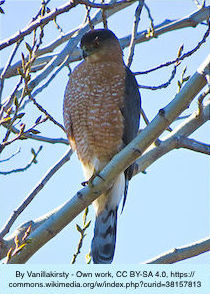 With this cold weather, we like to take extra treats out for the chickens and ducks. When we went out this afternoon with scratch, we noticed that the adult chickens were nowhere to be seen…very odd. The juvenile chickens were huddled in the back corner of the barn, and when we got closer, a hawk flew up and into the rafters. To our dismay, we discovered that the hawk had killed and had been eating one of the juveniles – a nice New Hampshire Red pullet, of course, one of the friendliest of the bunch. It had eaten much of the pullet’s head, which was detached, and had plucked most of the breast. *&#@ hawk!
With this cold weather, we like to take extra treats out for the chickens and ducks. When we went out this afternoon with scratch, we noticed that the adult chickens were nowhere to be seen…very odd. The juvenile chickens were huddled in the back corner of the barn, and when we got closer, a hawk flew up and into the rafters. To our dismay, we discovered that the hawk had killed and had been eating one of the juveniles – a nice New Hampshire Red pullet, of course, one of the friendliest of the bunch. It had eaten much of the pullet’s head, which was detached, and had plucked most of the breast. *&#@ hawk!
We had a problem at the end of last year with hawks preying on our laying hens, and we lost a significant number in a short period of time. This seems to be the time of year when, perhaps due to scarcity of wild food sources, the hawks come looking for meals at our farm. Yes, our birds are delicious, but we’d vastly prefer the raptors stick to catching mice and wild rabbits. Hmm…maybe they should look inside the plastic owls we put out to try to deter the hawks – we found a nest of mice in one of them recently. Needless to say, the plastic owls aren’t very effective.
Knowing the perils of free ranging our birds (especially after last year’s losses to predators), we ensure that we have enough birds that a small number of losses aren’t catastrophic. Pullets take almost 6 months (or more) to get to the point of lay, so there’s a lengthy lead time for a replacement to get up to speed. The juveniles need to learn to follow Fache, the flock rooster, when he signals that there’s danger; he had all of the adult hens in the coop, where they were safe. The juveniles, however, were bunched up in corner of the barn, just feet away from where their hatchmate was being eaten. Until they follow Fache’s lead, the youngsters are easy marks for sharp-eyed (and even sharper-taloned) hawks.
It was a bit puzzling was that the hawk chose a small New Hampshire Red cross pullet instead of one of the big, meaty young cockerels that were in the same area (and these cockerels aren’t the sharpest tools in the shed, if you catch our drift). The hawks, in fact, have only killed female chickens and ducks. Makes you wonder if the pullets are preferred because they pose a lower risk to the hawk, or maybe they have more fat..?
The hawk flew around in the rafters, panicked, trying to find an escape route, and finally flew out of an open doorway after a few minutes. Hopefully, the memory of the panicked escape attempt is stronger than the memory of the young, tasty pullet and the hawk doesn’t return. We’ll be doing extra checks outside for a while, though. In fact, it’s time to throw on the boots and take a quick jaunt around the barn…just in case. Guess that makes us the livestock guardian animals!
